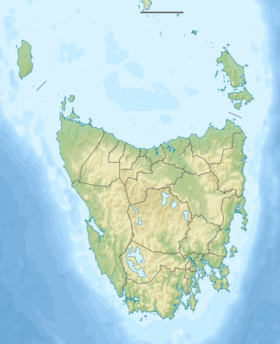Tarraleah Power Station
| Tarraleah Power Station | |
|---|---|
|
Penstocks feeding the Tarraleah Power Station | |
 Location in Tasmania | |
| Country | Australia |
| Location | Central Highlands, Tasmania |
| Coordinates | 42°18′05″S 146°27′26″E / 42.30139°S 146.45722°ECoordinates: 42°18′05″S 146°27′26″E / 42.30139°S 146.45722°E |
| Status | Operational |
| Construction began | November 1934 |
| Commission date |
|
| Owner(s) | Hydro Tasmania |
| Pumped-storage power station | |
| Upper reservoir | Lake King William |
| Upper res. capacity | 539,340 ML (19,047×106 cu ft) |
| Penstocks | 6 |
| Hydraulic head | 287 metres (942 ft) |
| Generating units |
|
| Pump-generators | 6 |
| Pumps | 2 |
| Power generation | |
| Units operational | 3-phase 50 hertz (6,000,000 m), 18.75 MVA synchronous generator |
| Make and model | English Electric |
| Nameplate capacity | 90 MW (120,000 hp) |
| Capacity factor | 0.8 |
| Average generation | 684 GWh (2,460 TJ) |
|
Website hydro | |
| [1] | |
The Tarraleah Power Station is a pumped-storage[2]:12 hydroelectric power station located in the Central Highlands region of Tasmania, Australia. The power station is part of the Upper Derwent hydro scheme and is operated by Hydro Tasmania.
History
The Upper River Derwent hydroelectric scheme was developed at a time in 1934 when the former Hydro-Electric Commission had only two working power stations.[2]:1 In 1934 the Derwent Valley Power Development power scheme was approved by the Parliament of Tasmania with the Tarraleah Power Station as the first completed power station of that scheme.[3] Ticklebelly Flat, the nickname for the married quarters at Tarraleah Camp number 2 in the 1930s, is a name for the history of Hydro Tasmania by Heather Fenton, known as Ticklebelly Tales.[4]
Power station

Part of the Derwent scheme that now comprises eleven hydroelectric power stations, the Tarraleah Power Station is located aboveground on the west bank of the Nive River downstream from the village of Tungatinah and a short distance from the Lyell Highway. The station draws its water from a variety of sources. Water from the concrete arched Clark Dam across the River Derwent that forms Lake King William flows from the lake and also from the Butlers Gorge Power Station around 25 kilometres (16 mi) via the Tarraleah Canals.[5][6][7]
The power station was opened in July 1938[8][9][10][11] and has six Pelton-type turbines, with a generating capacity of 90 megawatts (120,000 hp) of electricity. The station output is fed to the transmission grid via 11 kV metal clad switchgear and two 11 /110 kV 75MVA 3-phase power transformers.[6]
See also
References
- ↑ "Register of Large Dams in Australia" (Excel (requires download)). Dams information. Australian National Committee on Large Dams. 2010. Retrieved 23 June 2015.
- 1 2 "Tarraleah Power Development: 1938 to date" (PDF). Historic Engineering Marker Submission and Ceremony Report. Engineers Australia. 19 February 1998. Retrieved 4 July 2015.
- ↑ Felton, Heather (2008). Chapter 3: On the Upper Derwent. Ticklebelly Tales and other stories from the people of the Hydro. Hydro Tasmania. pp. 76–120. ISBN 978-0-646-47724-4.
- ↑ Lupton, Roger (1999). Lifeblood: Tasmania's hydro power (photo). Focus Publications. p. 118. ISBN 978-1-875359-33-2.
- ↑ "Upper Derwent Valley area". Community. Hydro Tasmania. Retrieved 4 July 2015.
- 1 2 "Tarraleah Power Station: Technical fact sheet" (PDF). Energy: Our power stations. Hydro Tasmania. Retrieved 21 June 2015.
- ↑ "Derwent: Tarraleah Power Station". Energy. Hydro Tasmania. Retrieved 4 July 2015.
- ↑ Tarraleah power development, Hydro-Electric Commission of Tasmania, 1938, retrieved 25 November 2014
- ↑ Austral Archaeology Pty Ltd (David Parham); Ian Terry (April 2007), Tarraleah Power Station—Conservation Management Plan (PDF), retrieved 1 February 2012
- ↑ Hydro Tasmania (2000), The Tarraleah Power Station : history, [Tasmania] Hydro Tasmania, retrieved 25 November 2014
- ↑ Terry, Ian (14 March 2006), "'The transformation of a wilderness': the development of the Tarraleah power station, 1934-1951", Papers and Proceedings, Tasmanian Historical Research Association, 53 (4): 197–209, ISSN 0039-9809
External links
- Koehnken, Lois; Eriksen, Ruth; Ray, Daniel; Brooks, Alistair (June 2011). "Derwent Catchment Review: Part 2 - Methodology and Data Analysis" (PDF). Derwent Catchment Review Steering Committee.
